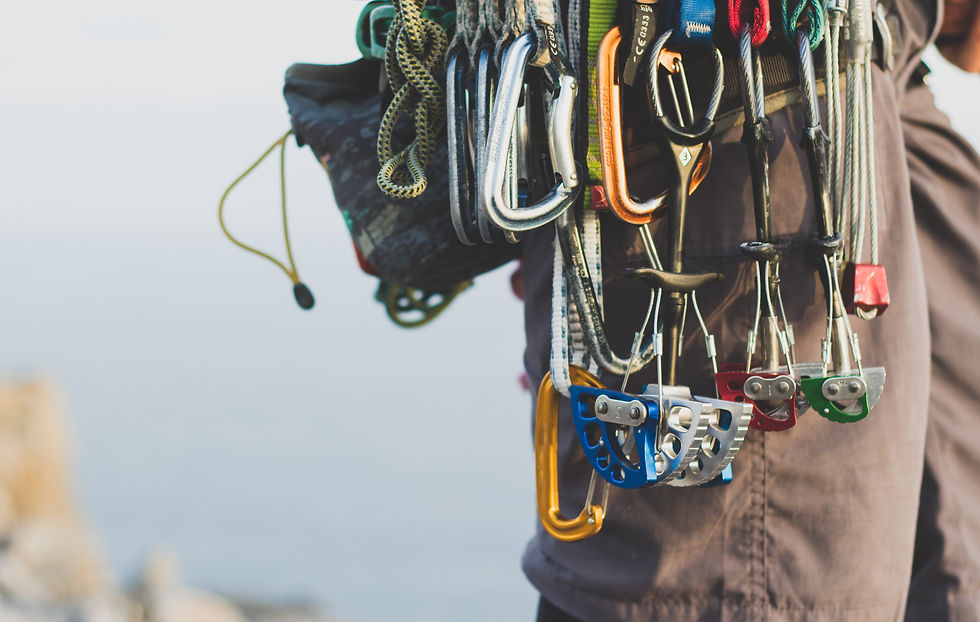A Beginner's Guide to Rock Climbing
- esteel8
- May 15, 2024
- 3 min read
The following guide is designed to introduce you to the basics of rock climbing, providing you with confidence and knowledge you need to start your climbing journey. Let's begin!

Types of Rock Climbing

Top Rope Climbing: This style of climbing is what you'll typically find in an indoor climbing gym. The safety rope goes from the climber to an anchor, a device that connects the climber or rope to the climbing surface. The anchor is placed at the top of the route and snakes back down to the belayer. The belayer uses a device on their harness that creates friction on the rope, allowing them to arrest the climber if they fall and lower them safely to the ground.

Bouldering: Bouldering typically only requires climbing shoes, chalk, and a crash pad to soften landings. The routes are usually very short and low-height, but demand technical skill and physical exertion to complete. Since safety gear like ropes are omitted in Bouldering, every fall will be a ground fall.

Sport Climbing: Similar to Top Rope Climbing, Sport Climbing has the same setup except that instead of the safety rope going through an anchor at the top of the climb, the climber will clip their rope to a series of fixed anchors as they ascend along their route.

Traditional (Trad) Climbing: Suited for the more advanced climber, Trad Climbing involves using removable gear instead of fixed gear. So, instead of navigating the climb with your rope looping through fixed anchors, the climber is armed with removable gear like wires, camming devices, and hexes. As they ascend, they place and remove the gear.
Where to Climb
Indoor Climbing Gym: With experienced staff, rental equipment, and various climbing styles, indoor climbing gyms are an ideal place for beginners to build skills, gain confidence, and focus on technique. They offer a safe and controlled environment without the added risks of outdoor climbing.
Outdoor Climbing: Once you've become a bit more seasoned, try opting for outdoor climbing. Research established climbing spots near you, or ask for recommendations from experienced climbers.

Essential Climbing Gear & Equipment
Climbing Shoes: Provides better grip on holds
Harness: Secures you to safety gear and the belayer
Belay and Carabiners: Used for belaying and connecting safety gear
Helmet: Protects you from head injuries, especially when outdoor climbing
Chalk: Helps maintain grip and prevents slipping
Crash Pad: Reduces impact from low-height ground falls

Important Safety & Training Recommendations
Learn from the Professionals: Take a beginner's climbing course at an indoor gym, or seek out certified instructors to teach you outdoor climbing.
Belaying: Understanding proper belaying techniques is crucial to your safety and others.
Etiquette: Respect other climbers, routes, and of course, the environment.
Climbing Partners: Climb with others when possible, or tell a trusted person of your plans before you go outdoor climbing.

Key Climbing Techniques
Footwork: Learn proper foot placement and how to drive power through your legs.
Weight-Shifting: Balance is an important aspect to climbing, as you're constantly pushing your hips over one foot or the other.
Grip & Holds: Familiarize yourself with different types of holds and how to use them effectively in different situations.
Breathing Pattern: Prioritize proper breathing techniques for intense physical exertion.

Advancing Your Skills
Build Strength and Flexibility: Climbing involves many complex moves that are facilitated through strength and mobility training.
Experiment with Climbing Styles: Try out different types of climbing styles to see which one resonates the best.
Join a Climbing Community or Club: Connect with other climbers for advice, support, and climbing buddies.

If you've made it to the end of this guide, you've already taken the first few steps into the thrilling world of rock climbing. We hope this guide provided you with a foundational understanding of climbing styles, essential gear, safety protocols, and basic technique. Get ready to conquer new heights!

Comments